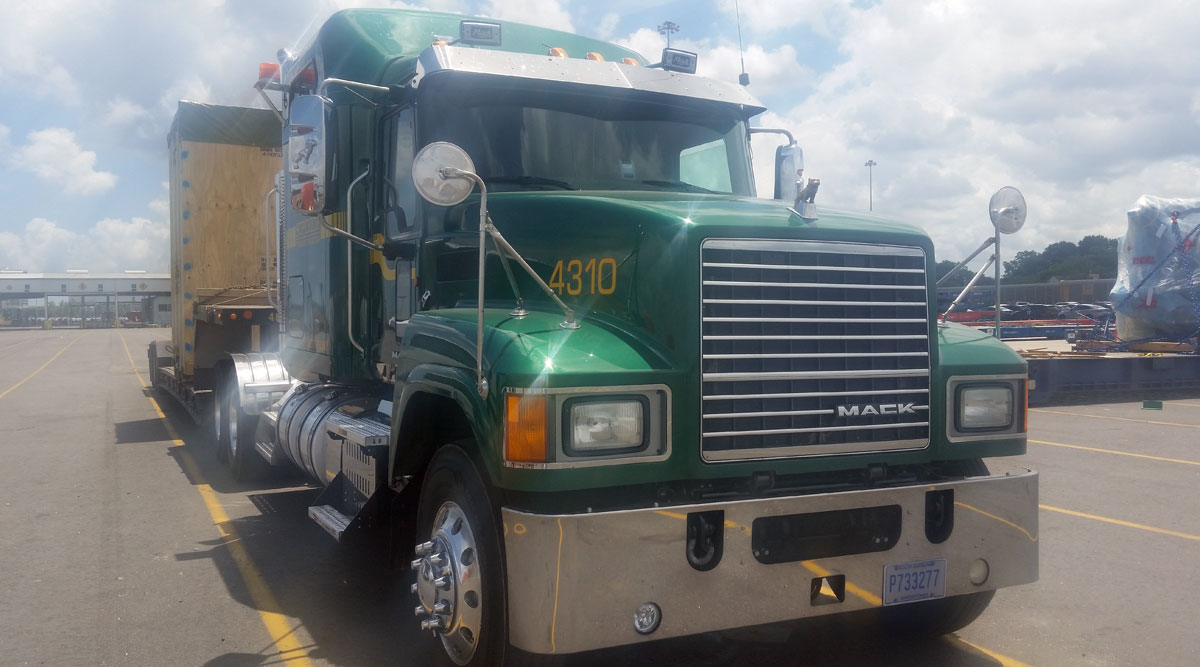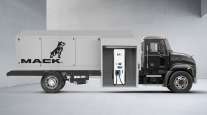Features Editor
Mack Trucks Sees Its AMTs Increasing Adoption in the Market

When Mack Trucks starting building trucks in 1907, it had “a completely proprietary powertrain and it took about 85 or 90 years for everybody else to catch up,” said Jonathan Randall, senior vice president of sales for Mack Trucks. “Now you see the rest of the industry kind of moving in the same direction with proprietary powertrains and drivetrains.”
Mack Trucks was “really the original disruptors of the commercial industry because we were the first ones to have a fully proprietary drivetrain,” Randall said, but noting that’s a bit tongue-in-cheek.
He spoke with TT during the truck maker’s “Born to Haul” press event May 18 that included a tour of the Port of Charleston. Mack, one of North America’s largest manufacturers of heavy-duty Class 8 trucks, engines and transmissions, is part of the Sweden-based Volvo Group.
Roy Horton, director of product strategy, said that for Mack Trucks, an integrated powertrain is the engine, transmission, driveline and rear axles, as well as the exhaust aftertreatment system. “It’s the configuration of those main components and how we optimize the performance and tailor the trucks for each of our customers’ applications,” Horton said.
As for its automated manual transmissions, Horton said the mDrive and mDrive HD have been a success “out of the gate.” The adoption rate year-over-year has increased in each model it has been offered in, he said, noting Mack Trucks has offered the mDrive in its highway model since 2010, and started offering it in its Granite vocational model in 2015.
The mDrive HD is an upgraded version of Mack’s 12-speed mDrive in its highway model, Horton said. “We upgraded it to make sure it could handle the vocational applications,” Horton said, noting the mDrive HD adds 13 and 14 speeds to offer slow speed “maneuverability” and “startability” that are needed for heavy haul applications.
Horton said there are some “cowboy-type” drivers who want to stick with trucks that have manual transmissions. However, once they drive with an mDrive, they really like them, Horton said, pointing out that mDrive automated manual transmissions help reduce driver fatigue.
At the end of a long week, there’s much less stress for the driver because they’re focused on driving and not shifting — “not having to push a clutch hundreds of times a day,” Randall added.
As for sales trends, Mack Trucks ended 2016 at an 8.9% market share in the United States and Canada, and ended the first quarter with a 10.1% market share, Randall said. The company continues to see the most traction in the construction and vocational markets, he said, noting this includes its dump trucks, cement mixers and water trucks, among others.
“We’re seeing a lot of activity and a lot of opportunity for growth,” Randall said. Another segment in which Mack sees a lot of opportunity is in regional haul and day cab, Randall said. “It’s continuing to be a larger portion, or a larger piece of the overall pie of the entire truck market.”
At the event, Pat Barber, president and CEO of Superior Transportation, a South Carolina-based heavy haul trucking company, and Tracy Gunter Jr. and his son Tracy Gunter III of Tracy’s Logging, a South Carolina-based logging business, were on hand to tout the durability and other benefits of Mack Trucks. Tracy’s Logging has Mack Granite model tractors in its fleet, while Superior has various Mack Pinnacle models.
Randall noted that over the past two years, the Class 8 over-the-road and long-haul truck segments have seen declines industrywide.
In “a normal market,” the on-highway segment accounts for about 50% of the total volume of Class 8 truck purchases, he said. “We participate but not to the ... level we want to, and so we are making product enhancements and product improvements to be seen down the road that make us more of a consideration in that market,” Randall said.
Turning to the regulatory environment, particularly future greenhouse gas regulations, one of the easiest ways to reduce emissions is to reduce fuel consumption, Randall said, noting they’re a “difficult proposition for all OEMs.” For Mack Trucks, the plan is in place and it’s moving forward to make sure it will meet the standards and the economic benefits for its customer base, he said.




